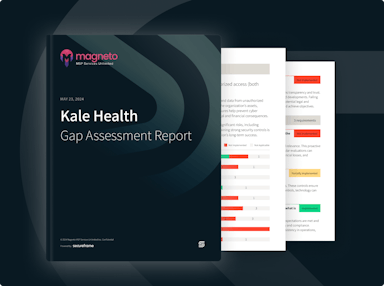
The Future of Compliance Automation: Trends and Predictions for 2025
Emily Bonnie
Senior Content Marketing Manager
Aaron Melear
VP of Partnerships and Alliances
As we reflect on 2024, it’s clear that the security and compliance landscape experienced significant changes. The surge in advanced cyber threats, including more sophisticated phishing and ransomware attacks, pushed organizations to focus on stronger threat detection and incident response. The rollout of updated regulatory standards such as CMMC 2.0, NIST CSF 2.0, DORA, and PCI DSS 4.0, also required organizations to reassess and expand their compliance practices. High-profile data breaches like the Change Healthcare, Ticketmaster, and AT&T incidents also highlighted the need for continuous monitoring and advanced third-party risk management.
Together, these changes have driven a growing reliance on automated compliance solutions, which enable organizations to simplify compliance processes while improving their overall security and operational resilience. Moving into 2025, compliance automation is set to play an even greater role, with advancements that will shape how MSPs serve their clients.
Let’s dive into the key trends predicted to drive the compliance automation landscape in 2025 and explore how MSPs can leverage these innovations to deliver top-tier security and compliance services for their clients.
AI-powered automation will provide deeper insights and greater efficiency
In 2025, compliance automation platforms are set to integrate increasingly sophisticated AI features that will enable MSPs to elevate their services, offering clients faster, more precise, and highly adaptive compliance management. By incorporating AI technologies, MSPs can transcend traditional compliance methods that rely on manual, repetitive processes.
AI-driven automation has already made a significant impact on helping MSPs streamline compliance workflows that previously required intensive manual effort. Repetitive tasks such as risk assessments, policy management, evidence collection, vulnerability remediation are now automated, freeing up MSPs to focus on strategic, high-value client support. This enhanced efficiency not only improves the MSP’s ability to serve more clients but also enables them to offer faster, more accurate compliance management, which is a critical differentiator in a competitive market.
In the coming years, workflow automation is set to become even more intelligent and adaptive, with AI continuously learning from user behavior to optimize task sequences. For example, if certain compliance tasks are frequently adjusted by users, the platform will be able to learn to automate these preferences and streamline workflows accordingly. This adaptive learning can improve efficiency by tailoring workflows to the unique needs of each organization, allowing them to manage compliance requirements with less effort and greater accuracy.
Similarly, AI-powered risk assessments have already made a tremendous impact on MSPs’ ability to identify, prioritize, and identify risks across their clients’ ecosystems. In 2025 and beyond, these algorithms will continue to advance to offer more refined predictive analytics that assess risk with greater precision. AI will use historical data, industry-specific patterns, and environmental factors to generate risk scores for specific compliance areas or assets, allowing organizations to anticipate vulnerabilities and take more effective preventive actions.
Compliance automation platforms have also incorporated AI to enable real-time third-party monitoring and risk assessment, allowing organizations to continuously assess the security and compliance postures of their vendors and partners. As machine learning continues to advance in the coming years, compliance platforms will be able to pull in data from external sources such as security ratings, threat intelligence feeds, and vendor audits, automatically flagging any changes in a third-party’s risk profile. This level of third-party risk visibility will empower organizations to protect their entire supply chain, addressing potential risks before they can be exploited.
In 2025, these AI-powered automation platforms will enable MSPs to deliver compliance solutions that are faster, smarter, and more adaptable than ever before. By adopting these technologies, MSPs will be well-positioned to provide clients with a future-ready compliance strategy that not only meets regulatory demands but also contributes to their long-term security, resilience, and business success.
Recommended reading

How MSPs and IT Service Providers Can Leverage AI and Machine Learning to Improve Cybersecurity
Continuous security and compliance monitoring will become standard practice
Traditionally, companies have met compliance standards by conducting annual assessments where they identify risks and vulnerabilities, remediate any issues, and revalidate their compliance status against relevant regulatory and security frameworks. But with the rapid pace of change in the cybersecurity landscape, this “snapshot” approach to compliance is now insufficient. As a result, organizations are beginning to adopt continuous compliance monitoring to maintain an up-to-date, real-time view of their security posture — a trend that will gain momentum in 2025.
In this new model, MSPs will play an instrumental role in facilitating this shift from periodic compliance checks to continuous, automated monitoring. By deploying compliance automation tools, MSPs can monitor a client’s compliance status continuously, scanning for potential risks and alerting stakeholders to changes as they occur. This real-time monitoring allows organizations to address issues immediately, minimizing the chance for vulnerabilities and compliance gaps to linger undetected.
This continuous monitoring also provides MSPs with a holistic view of their clients’ security landscape. Rather than evaluating compliance as a checklist of individual requirements, MSPs can use automated solutions to gain insights into interconnected risks across the organization. By identifying patterns such as repeated access anomalies or configuration changes, MSPs can help clients address underlying issues in their security infrastructure rather than simply meeting the minimum requirements for compliance. This approach also allows MSPs to move from reactive compliance support to proactive risk management, reducing the chance of fines, breaches, and costly downtime for their clients.
In 2025, more MSPs will leverage compliance automation to provide clients with a continuous, 360-degree view of their security posture, ensuring that they are not only meeting regulatory requirements but also prepared to defend against the latest threats. Armed with holistic, real-time data, MSPs will be able to provide strategic recommendations, flag high-priority risks, forecast potential compliance issues, and advise clients on improvements to strengthen their overall security posture.
Recommended reading

Why Compliance Automation is a Strategic Advantage for Modern Organizations
Third-party risk management will be a primary focus
As organizations increasingly recognize the risks posed by third-party relationships, they are turning to compliance automation to extend beyond internal controls and address vulnerabilities within their entire vendor ecosystem. In 2025, this awareness will drive a more proactive approach to third-party and vendor risk management, with compliance automation platforms integrating sophisticated third-party risk management (TPRM) features. Rather than treating vendor risk as a siloed concern, MSPs can use automation to integrate third-party risk data with their clients’ overall risk management framework.
Compliance automation tools with advanced TPRM capabilities allow MSPs to continuously monitor vendors' security postures, providing insights that were previously difficult, if not impossible, to maintain without intensive manual oversight. These platforms enable the automatic tracking of vendor compliance with security standards, monitoring for issues such as data protection practices, access controls, and incident response preparedness. MSPs can set up automated workflows that alert clients to conduct periodic vendor security reviews, establishing a layer of protection against third-party vulnerabilities that might otherwise go unchecked.
Compliance automation solutions in 2025 will increasingly support risk assessments tailored to specific vendor roles and the sensitivity of the data they handle. By implementing risk-based scoring models, MSPs can categorize vendors by their risk level and set customized monitoring requirements based on the nature of each relationship. For example, a critical vendor that accesses sensitive customer data would be subject to more rigorous monitoring than a vendor with minimal data access. Through this more nuanced approach, MSPs can help clients prioritize high-risk relationships and focus their resources on critical areas, creating a more efficient and targeted risk management strategy.
MSPs will leverage automated solutions to become strategic advisors for security and compliance
Compliance requirements are becoming more intricate, often involving nuanced interpretations of regulatory language, industry-specific guidelines, and an ever-growing array of cybersecurity standards. In response, MSPs are evolving to not only manage security tools but also to serve as trusted advisors who guide clients through best practices and align their security efforts with broader business goals.
Compliance automation platforms serve as the backbone of this shift, allowing MSPs to offer more than just technical assistance. With tools that track regulatory changes, automate risk assessments, and provide real-time reporting, MSPs can help clients implement structured, data-driven compliance programs tailored to their specific needs. MSPs will be able to provide clients with actionable insights that go beyond technical fixes, focusing on optimizing security postures, reducing compliance costs, and driving operational efficiencies. For example, instead of simply flagging a compliance gap, MSPs can help clients understand why that gap exists and how addressing it will enhance both security and business outcomes.
In addition to supporting day-to-day compliance, MSPs can use compliance automation platforms to help clients link security and compliance efforts to business growth. For instance, MSPs can highlight how achieving certain compliance milestones can open doors to new market opportunities or make the company more attractive to potential partners and customers. By reframing compliance as a strategic asset, MSPs empower clients to see compliance investments as integral to their growth, scalability, and competitive positioning. This consultative approach not only differentiates the MSP from other service providers but also builds trust and loyalty, creating a strong foundation for long-term partnerships.
Enhanced partnerships between MSPs, compliance automation vendors, and auditors
To meet the growing complexity of compliance needs, MSPs are recognizing the value of forming strategic partnerships with compliance automation vendors and auditors, which allow them to tap into a broader pool of resources, expertise, and technology. 2025 will see MSPs making efforts to build a cohesive network that leverages the strengths of each partner, enhancing their own service offerings and creating a more comprehensive support system for clients navigating the intricate compliance landscape.
By embedding automation into their service models, for example, MSPs can offer clients enhanced efficiency, accuracy, and visibility in their compliance efforts — services that would be challenging to deliver without the support of a trusted automation partner. Auditor partners contribute their deep understanding of regulatory standards and best practices. MSPs can collaborate with auditors to conduct mock audits, prepare clients for real audits, and develop audit-ready documentation and processes that meet the exacting requirements of various frameworks. By joining forces with both automation vendors and auditors, MSPs can offer a truly integrated approach that combines the strengths of technology and human expertise.
These alliances also empower MSPs to scale their services, making it easier to serve clients across diverse industries and compliance frameworks. Compliance demands vary significantly across sectors — healthcare, finance, manufacturing, and retail all have distinct regulatory needs. By leveraging the technology and expertise of specialized partners, MSPs can support a wider range of compliance requirements without spreading their own resources too thin. This scalability is especially valuable for MSPs looking to expand their client base or deepen relationships with clients in highly regulated industries.
Recommended reading

Secureframe Gap Assessment: A Free Tool to Empower Our Service Partners
Preparing for a more resilient future: The strategic role of MSPs and compliance automation
In 2025, MSPs that leverage compliance automation tools will be in the best position to offer clients a unique blend of technical expertise, strategic insight, and proactive support. This shift allows MSPs to become trusted partners who guide their clients through the intricate regulatory requirements that govern their industries while also helping to build and maintain resilient security postures that can adapt to evolving threats.
With AI-enhanced platforms, MSPs can help clients anticipate potential risks, automate complex workflows, and respond to incidents with unprecedented speed and accuracy. And with TPRM capabilities, MSPs can help clients secure their entire supply chain, addressing vulnerabilities that extend beyond internal systems to the vendors and partners their businesses depend on.
By focusing on service excellence and becoming strategic advisors, MSPs will not only help clients achieve compliance but also enable them to build a robust, proactive approach to security. This level of support goes beyond simply meeting regulatory demands — it actively contributes to creating a more resilient, secure, and agile business environment for clients.
As the leading security and compliance automation platform, Secureframe's Service Partner Program makes it easy for IT and security service providers to deliver security programs as part of an ongoing service. Learn more about our Service Partner Program to discover how we can help you scale your security and compliance offerings.
Join our Service Partner Program

Emily Bonnie
Senior Content Marketing Manager
Emily Bonnie is a seasoned digital marketing strategist with over ten years of experience creating content that attracts, engages, and converts for leading SaaS companies. At Secureframe, she helps demystify complex governance, risk, and compliance (GRC) topics, turning technical frameworks and regulations into accessible, actionable guidance. Her work aims to empower organizations of all sizes to strengthen their security posture, streamline compliance, and build lasting trust with customers.

Aaron Melear
VP of Partnerships and Alliances
Aaron Melear served as Vice President of Partnerships and Alliances at Secureframe, where he built and scaled the company’s global partner ecosystem. With over a decade of experience leading channel and alliance programs at top cybersecurity organizations—including Duo Security and Vanta—Aaron is passionate about helping partners accelerate revenue growth through automation, collaboration, and trust. During his tenure, he focused on empowering MSPs, auditors, and consulting partners to deliver faster, smarter compliance outcomes for their clients using Secureframe’s platform.